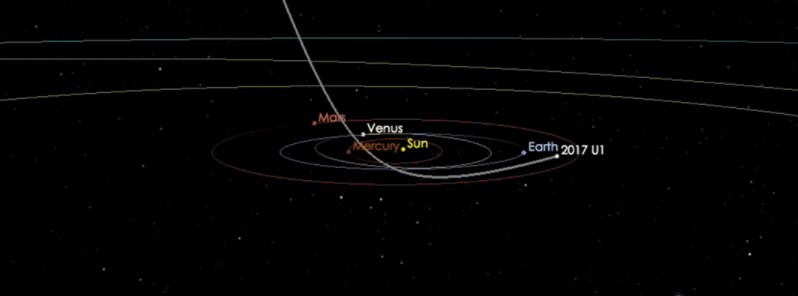First interstellar near-Earth object originating out of our solar system

Observations of a recently discovered near-Earth object currently designated A/2017 U1 suggest the object approached our solar system almost directly 'above' the ecliptic on September 9, 2017, and passed under Earth's orbit on October 14 at 60 lunar distances or 24 million km (15 million miles). At this time, it appears this asteroid, or comet, has originated from outside of our solar system. If confirmed, it would be the first 'interstellar object' to be observed and confirmed by astronomers.
The estimated diameter of A/2017 U1 is about 400 m (1 300 feet) but the object is moving remarkably fast and astronomers are urgently working to point telescopes around the world and in space at this notable object. Once these data are obtained and analyzed, astronomers may know more about the origin and possibly composition of the object.
The object was first identified by Rob Weryk, a postdoctoral researcher at the University of Hawaii Institute for Astronomy (IfA), on October 19 using the University of Hawaii's Pan-STARRS 1 telescope on Haleakala, Hawaii. Weryk spotted it during the course of its nightly search for near-Earth objects for NASA and immediately realized this was an unusual object. He consequently searched the Pan-STARRS archive and found the object in images taken the previous night, but not initially identified by the moving object processing.
Animation shows the path of A/2017 U1 as it passed through our inner solar system in September and October 2017. From the analysis of its motion, scientists calculate that it probably originated from outside of our solar system. Credit: NASA/JPL-Caltech
"Its motion could not be explained using either a normal solar system asteroid or comet orbit," he said.
Weryk contacted IfA graduate Marco Micheli, who had the same realization using his own follow-up images taken at the European Space Agency's telescope on Tenerife in the Canary Islands. But with the combined data, everything made sense. "This object came from outside our solar system," Weryk said.
"This is the most extreme orbit I have ever seen," said Davide Farnocchia, a scientist at NASA's Center for Near-Earth Object Studies (CNEOS) at the agency's Jet Propulsion Laboratory in Pasadena, California. "It is going extremely fast and on such a trajectory that we can say with confidence that this object is on its way out of the solar system and not coming back."
It's nice to get your own image of an interstellar visitor with @colinsnodgrass, thanks to the 4.2m WHT @INGLaPalma. Hello A/2012 U1! pic.twitter.com/hCsfk6wLWr
— Alan Fitzsimmons (@FitzsimmonsAlan) October 26, 2017
The CNEOS team plotted the object's current trajectory and even looked into its future. A/2017 U1 came from the direction of the constellation Lyra, cruising through interstellar space at a brisk clip of 25.5 km/s (15.8 mps).
According to CNEOS, the object approached our solar system from almost directly "above" the ecliptic, the approximate plane in space where the planets and most asteroids orbit the Sun, so it did not have any close encounters with the eight major planets during its plunge toward the Sun. On September 2, the small body crossed under the ecliptic plane just inside of Mercury's orbit and then made its closest approach to the Sun on September 9. Pulled by the Sun's gravity, the object made a hairpin turn under our solar system, passing under Earth's orbit on October 14 at a distance of about 24 million km (60 LD / 15 million miles). It has now shot back up above the plane of the planets and, traveling at 44 km/s (27 mps) with respect to the Sun, the object is speeding toward the constellation Pegasus.
The potential #interstellar object A/2017 U1, imaged earlier today!https://t.co/56wyqpAGxx pic.twitter.com/aZwu5C86sv
— Virtual Telescope (@VirtualTelescop) October 26, 2017
The small body has been assigned the temporary designation A/2017 U1 by the Minor Planet Center (MPC) in Cambridge, Massachusetts, where all observations on small bodies in our solar system – and now those just passing through – are collected.
"This kind of discovery demonstrates the great scientific value of continual wide-field surveys of the sky, coupled with intensive follow-up observations, to find things we wouldn't otherwise know are there," Matt Holman, MPC director, said.
Since this is the first object of its type ever discovered, rules for naming this type of object will need to be established by the International Astronomical Union.
"We have been waiting for this day for decades," said CNEOS Manager Paul Chodas. "It's long been theorized that such objects exist – asteroids or comets moving around between the stars and occasionally passing through our solar system – but this is the first such detection. So far, everything indicates this is likely an interstellar object, but more data would help to confirm it."
Featured image: A/2017 U1 path as it passed through our solar system – October 2017. Credit: NASA/JPL-Caltech

Commenting rules and guidelines
We value the thoughts and opinions of our readers and welcome healthy discussions on our website. In order to maintain a respectful and positive community, we ask that all commenters follow these rules:
We reserve the right to remove any comments that violate these rules. By commenting on our website, you agree to abide by these guidelines. Thank you for helping to create a positive and welcoming environment for all.